The mackerel is instantly recognisable by most people and hard to confuse with any other fish common to UK waters. It has a round slender body with two separate dorsal fins, plus finlets running from the rear of the second dorsal to the tail fin. Its colouring is an iridescent blue/green back with black banding and a white belly.
Rarely Spanish mackerel, a Mediterranean species, are caught amongst normal mackerel. These look similar, but the head is much bigger and the first dorsal stands higher up off the back in height than it does on common mackerel.
Mackerel range from North Africa to Northern Russia and Iceland, and are also found of the northeast coast of America. In Europe they are most common from The Bay of Biscay to southern Norway and are found all around the UK and Irish coast.
The season for mackerel is generally from early April through to late October, but in some southern areas in milder winters they can be found offshore virtually all year.
Juvenile mackerel feed on planktonic crustaceans and larvae, but as adults are predatory and take any small bait fish such as sprat, sandeels and herring.
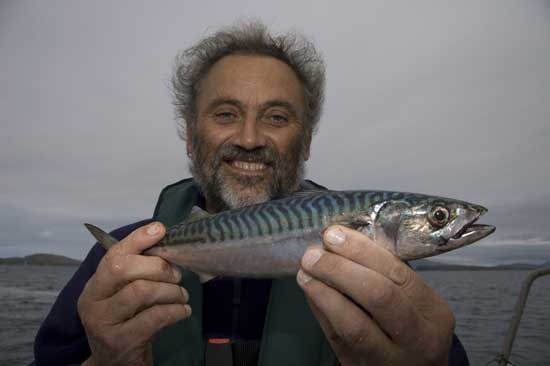
GARFISH FACTS
The garfish has a long slender body, round in shape, with elongated tooth filled jaws designed to grab and hold prey. The dorsal and anal fins are long at the base and set well back towards the tail. The colouration is a greeny back shading to bright silver sides and belly. The scales are large and often come off on your hands when handling garfish.
The skipper does look like the garfish, but this has a more compact deeper body, a larger head and the jaw teeth are smaller. The skipper though is found well offshore and is a much rarer rod and line catch.
Garfish are found all around the UK and Ireland, but are more common off the southern and west coasts. They also range as far north as central Norway, across to Iceland and south as far as the southern end of the Bay of Biscay.
Their diet includes small sandeels, sprat, herring, cod and even juvenile bass and mullet when feeding in harbours and estuaries. The garfish is often called the “scout” as it appears a few weeks before the mackerel, usually in early April and will stay inshore until late September, though numbers thin out in the northern half of Britain after July.
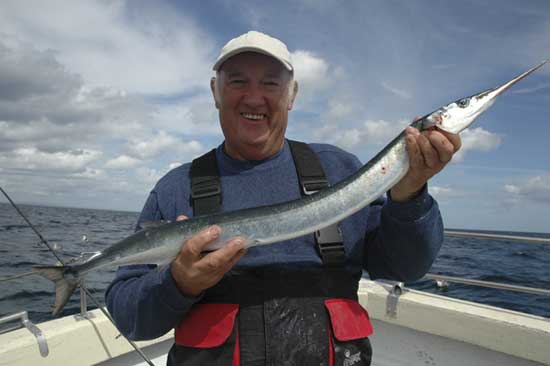
WHEN AND WHERE TO FISH
The best beaches for both mackerel and garfish are the steep-to shingle backed beaches such as Chesil and Dungeness where the depth encourages the mackerel shoals in on most tides from June through to September. The bigger tides always give the best fishing. Shallow surf beaches can also produce, but it will be for the hour either side of high water when the depth is at its greatest that the shoals move in closest.
Mackerel and garfish can also be caught during flood tides inside harbours, marina’s and from man mad breakwaters and jetties.
Coastal rock ledges in to deep water are also good marks to fish for mackerel and garfish and these can produce fish throughout both a flood and ebb tide due to the extra depth available. Mackerel will often shoal at dusk inside deep quiet coves boiling right in under the rock edges as they push baitfish in.
Both fish being hunters they tend to feed best from the shore at dusk and dawn when light levels are low. The hour before dusk is often the magic time with both mackerel and garfish pushing the shoals of sprat right in on to the beaches.
When boat fishing mackerel are often very easy to catch, but good skippers will look for areas where there is a run of tide over peaks of rock as this structure can often concentrate a shoal when other areas are barren. Mostly though mackerel will be well spread out and relatively easy to find, but during rough weather the shoals will split up and work the seabed, whereas in calmer weather they will range from mid depth to near the surface.
Garfish from the boat are best targeted by putting a bag of mashed fish over the side to bring the gars in. You can often see garfish behind the boat skittering on the surface 20-yards astern and with a practiced eye they are easy to spot.
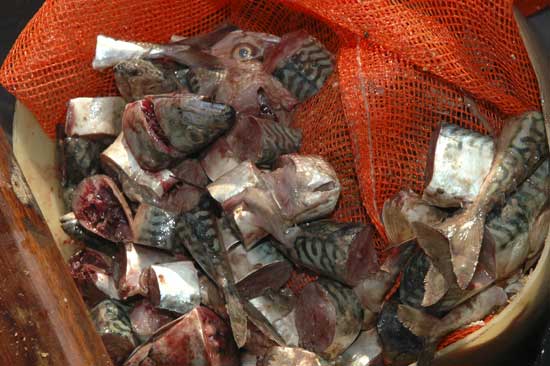
MACKEREL AND GARFISH TACKLE
When targeting mackerel for bait from a boat a 15 to 20lb class rod between 7ft 6in and 8ft is perfect! Match this to either a multiplier or fixed spool reel loaded with 300yds of 15 to 20lb line and 40lb shock leader as you may need to swing in four mackerel at a time.
Garfish are best fished for off the boat using a light 9ft to 10ft spinning rod with a 040 sized fixed spool reel, such as the Penn Sargus 4000 or Shimano or Daiwa equivelant and 8/10lb line. This same tackle is also perfect when fishing off the shore from piers, breakwaters, jetties and even the beach.
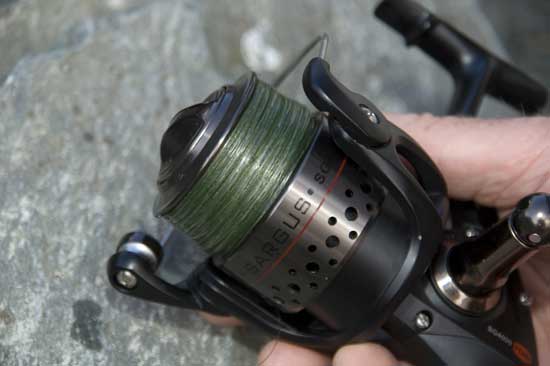
Shore fishing for mackerel then you can use the same spinning outfit detailed above when fishing spinners and float fishing, but if you’re looking to catch lots of mackerel, say for bait for the freezer, then you need to fish feathers and use a heavier 12 to 13ft beachcaster with a fixed spool or multiplier reel carrying 300yds of 15 to 18lb line and a 60lb shock leader.
HOW TO BUILD A MACKEREL/GARFISH FLOAT RIG
A simple rig incorporating an adjustable bubble float is perfect for targeting both mackerel and garfish from the shore and also off the boat with the spinning rod.
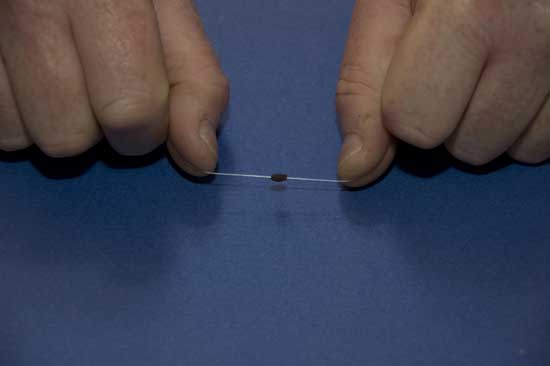
Slide a rubber float stop on to your main. Use two rubber stops if you need them to grip tighter.
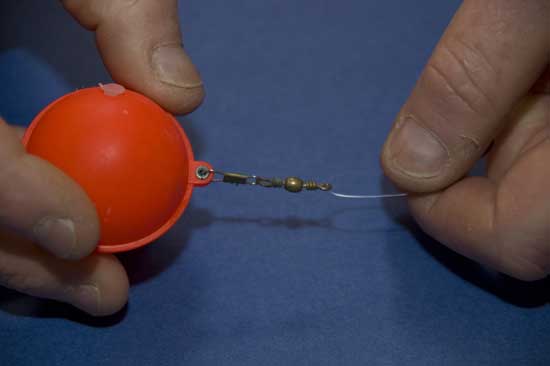
Attach a small link swivel to one eye of a medium sizes bubble float.
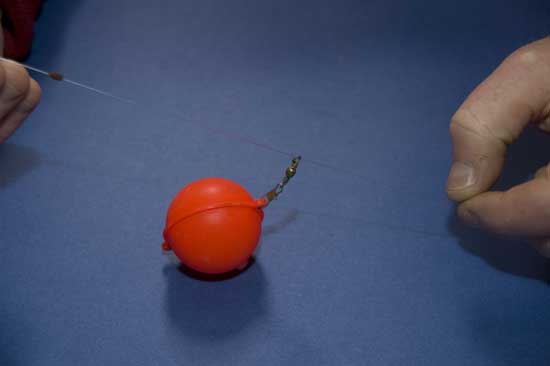
Slide the swivel via the free eye on to the line. Slide on another float stop.
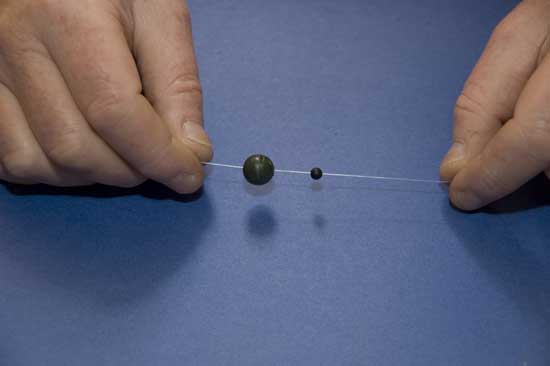
Slide on a small ball weight about ¼ oz followed by a small bead.
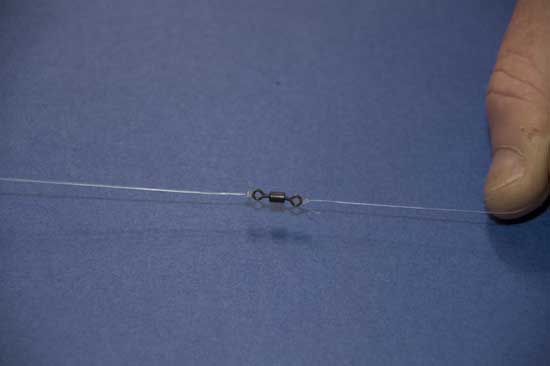
Tie on a small size 6 rolling swivel
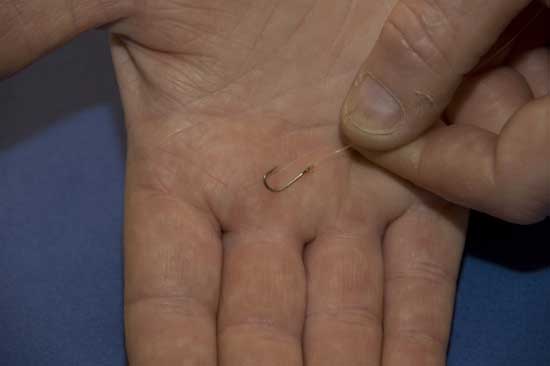
To the free eye of the tied swivel tie on 6-feet of 12 to 15lb clear mono or Fluoro carbon line. Finish with a size 4 hook for mackerel, but go down to a size 6 or 8 for the garfish.
The sliding rubber stops allow you to slide the bubble float up and down the line to adjust the depth at which the bait will fish suspended below the float. The light weight will be heavy enough in normal conditions to get the bait down to the fish.
LURES, FEATHERS AND BAITS
Mackerel will hit any lure when they’re feeding in a big shoal. Good spinners are ABU Toby’s in 20gm and 28gm, Dexter Wedges, chrome Slithers and pretty much any other lure that flashes and twists on the retrieve to simulate a wounded baitfish. At dusk a dark coloured or black 20gm Toby can be deadly. Small silver Mepps and Toby’s will catch garfish too.
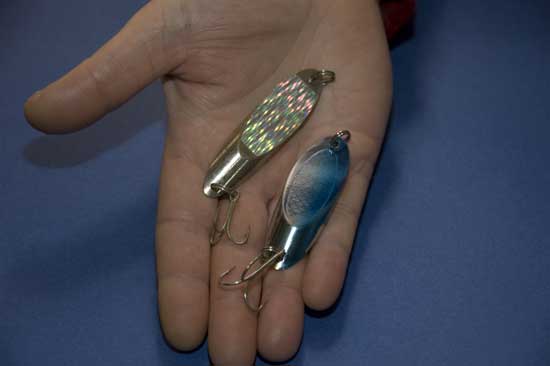
Even off the boat when the fish are feeding well, some feathers catch more than others. Again anything silver works well, and anything with red in will trigger a response. At dusk and dawn the best feather colours are red and black, especially the latter, but for some reason anglers seem reluctant to buy black feathers, yet it’s the best silhouette colour and will catch the most fish.
Both mackerel and garfish will take small strips of mackerel, squid and garfish when float fishing. Cut the strips to be about 1-inch long and no more than ½ -inch wide. Use only the belly skin flesh as this reflects well in the water and simulates a small bait fish.
TOP TIP 1
When boat fishing for mackerel in slightly coloured seas after a blow, choose feathers with a luminous body such as small Hokkai’s or switch to luminous shrimp rigs. The mackerel are better able to home in on the luminous bodies in the low water clarity and you’ll catch more fish.
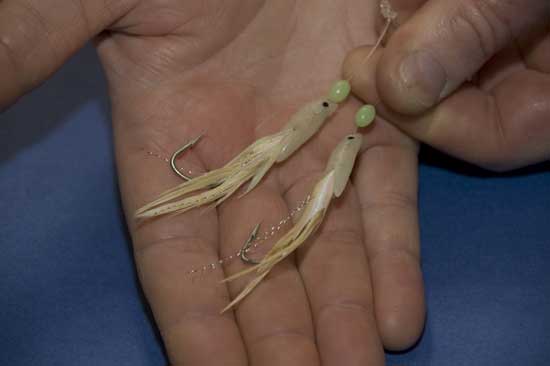
TOP TIP 2
Again after rough weather when the mackerel are split up in to small groups, they will be concentrated on or very near the seabed where the turbulence from the sea swell is least felt. Concentrate your fishing here for the best results.
In calmer clear seas, start by dropping the feathers to say 20-feet deep and jig the rod and feathers up and down to locate the fish. If no bites come drop another 10-feet and so on until the depth at which the fish are feeding is found.
TOP TIP 3
When shore casting for mackerel, cast out as far as you can and wait until you feel the lead hit the seabed. Now lift the rod up in an upwards sweep, and as you drop the rod tip back down prior to the next upward sweep, reel in the sack line. This sink and draw method is deadly for mackerel and far more effective than a steady retrieve which is a mistake many newcomers to mackerel fishing make.
TOP TIP 4
In harbours use the height of the breakwater and quay to look down in to the water. Often you’ll see garfish swimming about and this makes a specific feeding area easy to identify.
If you can’t see fish, having a bucket of mashed bread and minced up fish and using an old wooden spoon keep flicking a little in to the water every few minutes. This groundbait will draw mackerel, garfish and small pollack in to the area giving you a better chance of success.
TOP TIP 5
When targeting garfish off the back of the boat, set the float to be about 8-feet above the hook. Add a small split shot to the hook trace about 2-feet above the hook, now let the float drift away from the boat with the tide, periodically stopping the float to lift the bait up in the water, then flutter back down. The gars usually hit the bait when the bait lifts upwards.
If the gars won’t bite as the bait lifts draw it back towards you a few feet very slowly and you’ll feel them nip at the bait before taking it in.
If you can see the gars behind the boat but they won’t take the bait, then also try dropping down to a 12lb Fluorocarbon hook trace as gars have great eyesight and can often be put off by heavy line.
Rarely Spanish mackerel, a Mediterranean species, are caught amongst normal mackerel. These look similar, but the head is much bigger and the first dorsal stands higher up off the back in height than it does on common mackerel.
Mackerel range from North Africa to Northern Russia and Iceland, and are also found of the northeast coast of America. In Europe they are most common from The Bay of Biscay to southern Norway and are found all around the UK and Irish coast.
The season for mackerel is generally from early April through to late October, but in some southern areas in milder winters they can be found offshore virtually all year.
Juvenile mackerel feed on planktonic crustaceans and larvae, but as adults are predatory and take any small bait fish such as sprat, sandeels and herring.

GARFISH FACTS
The garfish has a long slender body, round in shape, with elongated tooth filled jaws designed to grab and hold prey. The dorsal and anal fins are long at the base and set well back towards the tail. The colouration is a greeny back shading to bright silver sides and belly. The scales are large and often come off on your hands when handling garfish.
The skipper does look like the garfish, but this has a more compact deeper body, a larger head and the jaw teeth are smaller. The skipper though is found well offshore and is a much rarer rod and line catch.
Garfish are found all around the UK and Ireland, but are more common off the southern and west coasts. They also range as far north as central Norway, across to Iceland and south as far as the southern end of the Bay of Biscay.
Their diet includes small sandeels, sprat, herring, cod and even juvenile bass and mullet when feeding in harbours and estuaries. The garfish is often called the “scout” as it appears a few weeks before the mackerel, usually in early April and will stay inshore until late September, though numbers thin out in the northern half of Britain after July.

WHEN AND WHERE TO FISH
The best beaches for both mackerel and garfish are the steep-to shingle backed beaches such as Chesil and Dungeness where the depth encourages the mackerel shoals in on most tides from June through to September. The bigger tides always give the best fishing. Shallow surf beaches can also produce, but it will be for the hour either side of high water when the depth is at its greatest that the shoals move in closest.
Mackerel and garfish can also be caught during flood tides inside harbours, marina’s and from man mad breakwaters and jetties.
Coastal rock ledges in to deep water are also good marks to fish for mackerel and garfish and these can produce fish throughout both a flood and ebb tide due to the extra depth available. Mackerel will often shoal at dusk inside deep quiet coves boiling right in under the rock edges as they push baitfish in.
Both fish being hunters they tend to feed best from the shore at dusk and dawn when light levels are low. The hour before dusk is often the magic time with both mackerel and garfish pushing the shoals of sprat right in on to the beaches.
When boat fishing mackerel are often very easy to catch, but good skippers will look for areas where there is a run of tide over peaks of rock as this structure can often concentrate a shoal when other areas are barren. Mostly though mackerel will be well spread out and relatively easy to find, but during rough weather the shoals will split up and work the seabed, whereas in calmer weather they will range from mid depth to near the surface.
Garfish from the boat are best targeted by putting a bag of mashed fish over the side to bring the gars in. You can often see garfish behind the boat skittering on the surface 20-yards astern and with a practiced eye they are easy to spot.

MACKEREL AND GARFISH TACKLE
When targeting mackerel for bait from a boat a 15 to 20lb class rod between 7ft 6in and 8ft is perfect! Match this to either a multiplier or fixed spool reel loaded with 300yds of 15 to 20lb line and 40lb shock leader as you may need to swing in four mackerel at a time.
Garfish are best fished for off the boat using a light 9ft to 10ft spinning rod with a 040 sized fixed spool reel, such as the Penn Sargus 4000 or Shimano or Daiwa equivelant and 8/10lb line. This same tackle is also perfect when fishing off the shore from piers, breakwaters, jetties and even the beach.

Shore fishing for mackerel then you can use the same spinning outfit detailed above when fishing spinners and float fishing, but if you’re looking to catch lots of mackerel, say for bait for the freezer, then you need to fish feathers and use a heavier 12 to 13ft beachcaster with a fixed spool or multiplier reel carrying 300yds of 15 to 18lb line and a 60lb shock leader.
HOW TO BUILD A MACKEREL/GARFISH FLOAT RIG
A simple rig incorporating an adjustable bubble float is perfect for targeting both mackerel and garfish from the shore and also off the boat with the spinning rod.

Slide a rubber float stop on to your main. Use two rubber stops if you need them to grip tighter.

Attach a small link swivel to one eye of a medium sizes bubble float.

Slide the swivel via the free eye on to the line. Slide on another float stop.

Slide on a small ball weight about ¼ oz followed by a small bead.

Tie on a small size 6 rolling swivel

To the free eye of the tied swivel tie on 6-feet of 12 to 15lb clear mono or Fluoro carbon line. Finish with a size 4 hook for mackerel, but go down to a size 6 or 8 for the garfish.
The sliding rubber stops allow you to slide the bubble float up and down the line to adjust the depth at which the bait will fish suspended below the float. The light weight will be heavy enough in normal conditions to get the bait down to the fish.
LURES, FEATHERS AND BAITS
Mackerel will hit any lure when they’re feeding in a big shoal. Good spinners are ABU Toby’s in 20gm and 28gm, Dexter Wedges, chrome Slithers and pretty much any other lure that flashes and twists on the retrieve to simulate a wounded baitfish. At dusk a dark coloured or black 20gm Toby can be deadly. Small silver Mepps and Toby’s will catch garfish too.

Even off the boat when the fish are feeding well, some feathers catch more than others. Again anything silver works well, and anything with red in will trigger a response. At dusk and dawn the best feather colours are red and black, especially the latter, but for some reason anglers seem reluctant to buy black feathers, yet it’s the best silhouette colour and will catch the most fish.
Both mackerel and garfish will take small strips of mackerel, squid and garfish when float fishing. Cut the strips to be about 1-inch long and no more than ½ -inch wide. Use only the belly skin flesh as this reflects well in the water and simulates a small bait fish.
TOP TIP 1
When boat fishing for mackerel in slightly coloured seas after a blow, choose feathers with a luminous body such as small Hokkai’s or switch to luminous shrimp rigs. The mackerel are better able to home in on the luminous bodies in the low water clarity and you’ll catch more fish.

TOP TIP 2
Again after rough weather when the mackerel are split up in to small groups, they will be concentrated on or very near the seabed where the turbulence from the sea swell is least felt. Concentrate your fishing here for the best results.
In calmer clear seas, start by dropping the feathers to say 20-feet deep and jig the rod and feathers up and down to locate the fish. If no bites come drop another 10-feet and so on until the depth at which the fish are feeding is found.
TOP TIP 3
When shore casting for mackerel, cast out as far as you can and wait until you feel the lead hit the seabed. Now lift the rod up in an upwards sweep, and as you drop the rod tip back down prior to the next upward sweep, reel in the sack line. This sink and draw method is deadly for mackerel and far more effective than a steady retrieve which is a mistake many newcomers to mackerel fishing make.
TOP TIP 4
In harbours use the height of the breakwater and quay to look down in to the water. Often you’ll see garfish swimming about and this makes a specific feeding area easy to identify.
If you can’t see fish, having a bucket of mashed bread and minced up fish and using an old wooden spoon keep flicking a little in to the water every few minutes. This groundbait will draw mackerel, garfish and small pollack in to the area giving you a better chance of success.
TOP TIP 5
When targeting garfish off the back of the boat, set the float to be about 8-feet above the hook. Add a small split shot to the hook trace about 2-feet above the hook, now let the float drift away from the boat with the tide, periodically stopping the float to lift the bait up in the water, then flutter back down. The gars usually hit the bait when the bait lifts upwards.
If the gars won’t bite as the bait lifts draw it back towards you a few feet very slowly and you’ll feel them nip at the bait before taking it in.
If you can see the gars behind the boat but they won’t take the bait, then also try dropping down to a 12lb Fluorocarbon hook trace as gars have great eyesight and can often be put off by heavy line.

